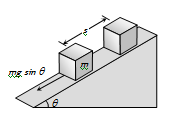12th Grade > Physics
WORK POWER AND ENERGY MCQs
Work And Energy, Sources Of Energy, Electric Potential Energy Potential And Dipoles
Total Questions : 109
| Page 6 of 11 pages
Question 51. A force F=−K(yi+aj) (where K is a positive constant) acts on a particle moving in the xy-plane. Starting from the origin, the particle is taken along the positive x-axis to the point (a, 0) and then parallel to the y-axis to the point (a, a). The total work done by the force F on the particles is
Answer: Option C. -> −Ka2
:
C
While moving from (0,0) to (a,0)
Along positive x-axis, y = 0 ∴→F=−kx^j
i.e. force is in negative y-direction while displacement is in positive x-direction.
∴W1=0
Because force is perpendicular to displacement
Then particle moves from (a,0) to (a,a) along a line parallel to y-axis (x = +a) during this→F=−k(y^i+a^j)
The first component of force, −ky^i will not contribute any work because this components is along negative x-direction (−^i)while displacement is in positive y-direction (a,0) to (a,a).
The second component of force i.e. −ka^j
∴W2=(−ka^j)(a^j)=(−ka)(a)=−ka2
So net work done on the particle W=W1+W2
=0+(−ka2)=−ka2
:
C
While moving from (0,0) to (a,0)
Along positive x-axis, y = 0 ∴→F=−kx^j
i.e. force is in negative y-direction while displacement is in positive x-direction.
∴W1=0
Because force is perpendicular to displacement
Then particle moves from (a,0) to (a,a) along a line parallel to y-axis (x = +a) during this→F=−k(y^i+a^j)
The first component of force, −ky^i will not contribute any work because this components is along negative x-direction (−^i)while displacement is in positive y-direction (a,0) to (a,a).
The second component of force i.e. −ka^j
∴W2=(−ka^j)(a^j)=(−ka)(a)=−ka2
So net work done on the particle W=W1+W2
=0+(−ka2)=−ka2
Answer: Option C. -> Both kinetic and potential energies may increase
:
C
Work done will convert into energies - both Kinetic and Potential
:
C
Work done will convert into energies - both Kinetic and Potential
Answer: Option A. -> 5.28 J
:
A
v=dxdt=3−8t+3t2
∴v0=3m/sandv4=19m/s
W=12m(v24−v20) (According to work energy theorem)
=12×0.03×(192−32)=5.28J
:
A
v=dxdt=3−8t+3t2
∴v0=3m/sandv4=19m/s
W=12m(v24−v20) (According to work energy theorem)
=12×0.03×(192−32)=5.28J
Answer: Option C. -> 60∘
:
C
W=Fscosθ
⇒cosθ=WFs=2550=12
⇒θ=cos−1(12)
⇒θ=60∘
:
C
W=Fscosθ
⇒cosθ=WFs=2550=12
⇒θ=cos−1(12)
⇒θ=60∘
Answer: Option D. -> Work
:
D
Work is a dot product of force and displacement and hencea scalar.
:
D
Work is a dot product of force and displacement and hencea scalar.
Answer: Option A. -> 16 times
:
A
Work = Force × Displacement
If unit of force and length be increased by four times then the unit of energy will increase by 16 times.
:
A
Work = Force × Displacement
If unit of force and length be increased by four times then the unit of energy will increase by 16 times.
Answer: Option A. -> 20
:
A
→A.→B = |A||B|cos60∘ .
|¯¯¯¯A|=4 ;|¯¯¯¯B|=10
= 4×10×12
Scalar product of→A &→B = 20
:
A
→A.→B = |A||B|cos60∘ .
|¯¯¯¯A|=4 ;|¯¯¯¯B|=10
= 4×10×12
Scalar product of→A &→B = 20
Answer: Option B. -> √2Rg
:
B
By applying law of conservation of energy
mgR = 12mv2
⇒v=√2Rg
:
B
By applying law of conservation of energy
mgR = 12mv2
⇒v=√2Rg
Answer: Option D. -> 180∘
:
D
⃗A.⃗B=|A||B|cosθor,cosθ=⃗A.⃗B|A||B| ----------------(i)
But, ⃗A.⃗B=(^i+^j+^k).(−2^i−2^j−2^k)
⃗A.⃗B=−2−2−2
⃗A.⃗B=−2−2−2=−6
Again A = |⃗A|=√(1)2+(1)2+(1)2=√3;
B = |⃗B|=√(−2)2+(−2)2+(−2)2=√12=2√3
Now,cosθ=−6√3×2√3=−1⇒θ=180∘
:
D
⃗A.⃗B=|A||B|cosθor,cosθ=⃗A.⃗B|A||B| ----------------(i)
But, ⃗A.⃗B=(^i+^j+^k).(−2^i−2^j−2^k)
⃗A.⃗B=−2−2−2
⃗A.⃗B=−2−2−2=−6
Again A = |⃗A|=√(1)2+(1)2+(1)2=√3;
B = |⃗B|=√(−2)2+(−2)2+(−2)2=√12=2√3
Now,cosθ=−6√3×2√3=−1⇒θ=180∘

















